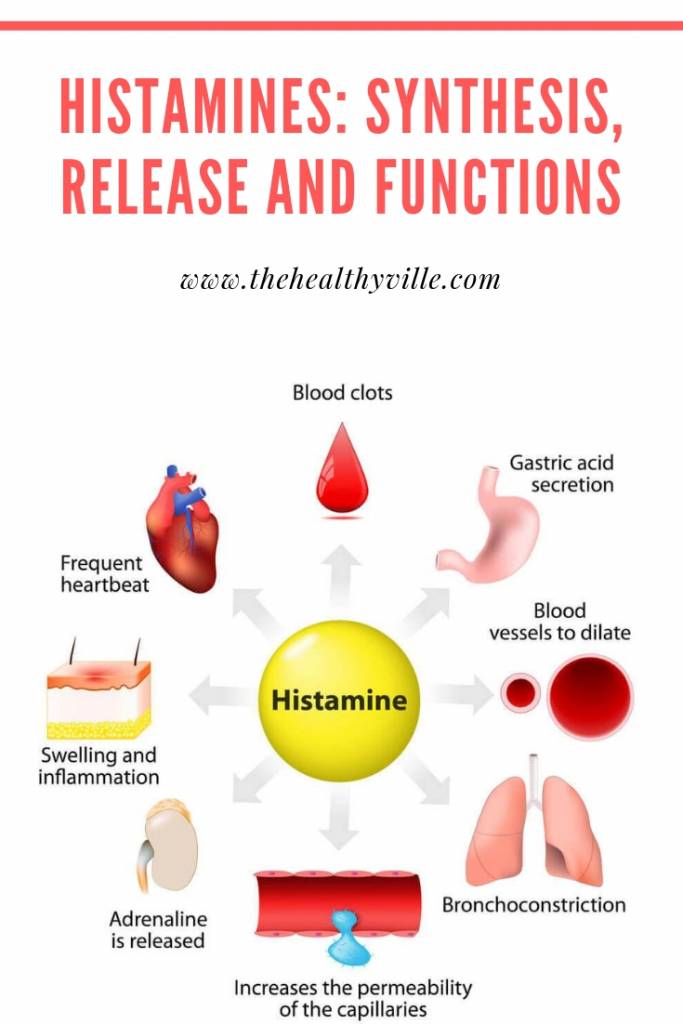Histamines are endogenous substances stored in cells called mast cells. They participate in numerous physiological processes. Discover which.
Histamine is an idazoic amine that which is part of the local responses of the immune system. This molecule also regulates normal functions in the stomach and acts as a neurotransmitter in the central nervous system (CNS). Outside the CNS, it acts as a mediator of numerous physiological processes.
Since the 50s, we know that this molecule is in the brain, but until recently we were not familiar with its functions, which we will see later in more detail.
In the system, histamine is mainly in mast cells of the connective tissue and basophil cells of the blood. These cells are eminently secretory and constitute a system that responds to a great variety of endogenous and exogenous stimuli through multiple cellular mechanisms.
Under normal conditions, the mast cell histamine is stored in secretory granules containing a matrix of heparin and various proteins. Along with several hydrolases, it connects, for the most part, to the matrix by ionic bonds, but a small part can be in free form.
Release mechanisms
Histamines participate in numerous physiological processes. Among them, it is an important regulator of neurotransmitters.
In order for histamine to be released, it must cross the granular and cellular membrane. The release can be cytotoxic, after the rupture of both membranes, or exocytotic, by the previous fusion of these, without cellular deterioration.
Histamines are released in the course of physiological processes such as the secretion of gastric juice. However, its participation in pathological processes is much better known, in which it is released more or less explosively, as in inflammatory reactions and immediate hypersensitivity reactions.
In these cases, frequently, histamine is one more of the mediators that are released simultaneously.
There are multiple physical and chemical agents that cause the release of histamine. Among physicists are:
- Hot.
- Radiation.
- Cold.
- Trauma
As for the second ones, the number and variety are extraordinary and have to find in the membrane receptor molecules with which they interact.
Depending on the type of interaction, sequences of different steps will activate that will invariably end up raising the intracellular calcium concentration. Among these stimuli we can name, for example:
- Antigens
- Cytotoxic agents.
- Enzymes
General response of histamine in the human body
Histamines are the most representative molecules in anaphylactic shock. Before the allergens, a massive exit from the cells takes place.
When doctors inject histamine into the general circulation, it can cause reddening of the skin, tachycardia, throbbing headache and hypotension. These effects are directly dependent on the dose, that is, when the doctor increases the dose of histamine, they enhance the effects.
Locally, it produces edema, pruritus, urticaria and bronchoconstriction. In addition, histamine contributes with other mediators to anaphylactic shock. On the other hand, its role in the immune response, in inflammation, gastric secretion and circulatory regulation is evident, among other functions that we will see below.
Functions of histamines in the body
There are many functions that histamine defects in our body. Among them we will highlight 5.
Allergic processes
Histamine is a modulator of both the humoral and cellular immune responses, as well as the major mediator of hypersensitivity reactions. If applied in large doses or released during anaphylaxis, it causes a profound decrease in blood pressure.
Neurotransmission
On the other hand, histamine can act as a neuromodulator, regulating responses to other neutransmitters. It interacts like acetylcholine, opiates, GABA, etc. In addition, it increases the excitability of the CNS neurons. It regulates hypothalamic functions, waking / sleeping relationship, regulates appetite and vegetative functions.
Cardiovascular regulation
With an important immunological role, histamine causes vasodilation to attract more immune cells.
It acts as a vasodilator when interacting with its receptors. The release of histamine leads to an increase in capillary permeability due to effects on small vessels, as a result of the release of plasma proteins and fluids into the extracellular spaces.
Further info: You’re At Risk Of Cardiovascular Disease And Stroke If You Notice These 5 Signs!
Action on extravascular smooth muscle
This substance produces contraction of the smooth muscles. The answers will vary widely even in the same person. Small doses of the molecule also trigger bronchoconstriction in people with bronchial asthma, as we saw earlier.
Gastric juice secretion
Histamines act as potent gastric secretagogues and trigger the excretion of acid by the parietal cells. In addition, it also significantly increases the production of pepsinogen and intrinsic factor. Therefore, it is the predominant mediator of acid secretion of the stomach, by stimulation of H2 receptors.
Don’t forget to SHARE the important information on histamines with your friends and family on your social networks!

